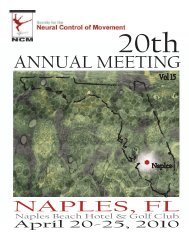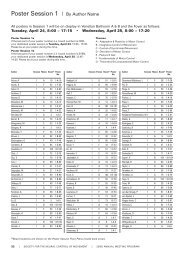2012 Program - Society for the Neural Control of Movement
2012 Program - Society for the Neural Control of Movement
2012 Program - Society for the Neural Control of Movement
Create successful ePaper yourself
Turn your PDF publications into a flip-book with our unique Google optimized e-Paper software.
Optimal control <strong>of</strong> eye-head movements with<br />
changing head plant characteristics<br />
Stefan Glasauer1, Murat Saglam2, Nadine Lehnen2 1Klinikum der Universität München, 2Ludwig-Maximilian University<br />
Large gaze shifts from one visual target to <strong>the</strong> next usually involve<br />
combined eye and head movements. While <strong>the</strong>re are infinitely many<br />
possible solutions to <strong>the</strong> problem <strong>of</strong> choosing a movement,<br />
experiments show that <strong>the</strong> contributions <strong>of</strong> eye and head and <strong>the</strong><br />
trajectories chosen are stereotyped. This suggests an underlying<br />
general principle governing <strong>the</strong> movement choice. We recently<br />
showed that basically all features <strong>of</strong> natural human eye-head<br />
movements - including <strong>the</strong> part where gaze is already on target and<br />
<strong>the</strong> eye counter-rotates - are reproduced by an optimal control model<br />
minimizing <strong>the</strong> impact <strong>of</strong> two types <strong>of</strong> noise, namely signalindependent<br />
or constant and signal-dependent noise, on <strong>the</strong><br />
variability <strong>of</strong> <strong>the</strong> final gaze position after <strong>the</strong> gaze shift (Saglam et al. J<br />
Neurosci 31: 16185-93, 2011). Thus, <strong>the</strong> optimization criterion only<br />
takes into account <strong>the</strong> desired goal <strong>of</strong> stabilizing gaze on <strong>the</strong> newly<br />
selected target, but not o<strong>the</strong>r possible constraints that has previously<br />
been proposed, such as minimal ef<strong>for</strong>t. Due to including constant<br />
noise, <strong>the</strong> present model not only predicts features such as relative<br />
contributions <strong>of</strong> eye and head or <strong>the</strong> time course <strong>of</strong> <strong>the</strong> movement,<br />
but also movement duration.<br />
In <strong>the</strong> present work, we ask whe<strong>the</strong>r and how changes in <strong>the</strong><br />
dynamical characteristics <strong>of</strong> <strong>the</strong> effectors are taken into account <strong>for</strong><br />
control <strong>of</strong> movement. Immediately after experimentally increasing <strong>the</strong><br />
head inertia characteristic head oscillations around <strong>the</strong> end-point <strong>of</strong><br />
<strong>the</strong> head can be observed, while gaze remains stable because <strong>the</strong><br />
eyes counter-rotate. Here we show that, according to <strong>the</strong> model, head<br />
oscillations during <strong>the</strong> gaze stabilization phase increase movement<br />
cost by increasing variability during <strong>the</strong> gaze-stabilized postmovement<br />
period. Consequently, head movements should be<br />
adjusted to avoid <strong>the</strong> costly oscillations. Experimentally, such<br />
adjustments can be seen with time constants <strong>of</strong> about ten trials in<br />
healthy subjects but not in labyrinthine-defective patients. This<br />
indicates that <strong>the</strong> motor command ei<strong>the</strong>r alone or toge<strong>the</strong>r with <strong>the</strong><br />
internal model <strong>of</strong> <strong>the</strong> head plant is modified using vestibular feedback.<br />
We discuss implications <strong>for</strong> possible mechanisms <strong>of</strong> optimization,<br />
adaptation and learning <strong>of</strong> novel plant characteristics.<br />
Acknowledgement: supported by <strong>the</strong> BMBF (grant 01EO0901).<br />
INDIVIDUAL PRESENTATIONS V<br />
Session 12<br />
Friday, April 27<br />
15:00 – 17:00<br />
A novel computational approach helps explain and<br />
reconcile conflicting experimental findings on <strong>the</strong><br />
neural control <strong>of</strong> arm endpoint stiffness<br />
Joshua Inouye1, Francisco Valero-Cuevas1 1University <strong>of</strong> Sou<strong>the</strong>rn Cali<strong>for</strong>nia<br />
Much debate has arisen from conflicting experimental findings <strong>of</strong> limb<br />
impedance control during reaching movements--particularly about<br />
neural regulation <strong>of</strong> stiffness and its energetic consequences. Some<br />
find that <strong>the</strong> eccentricity and orientation <strong>of</strong> arm endpoint stiffness<br />
ellipsoids can be tuned arbitrarily in response to unstable <strong>for</strong>ce fields<br />
during reaching movements [1-4]. O<strong>the</strong>rs come to nearly <strong>the</strong> opposite<br />
conclusion: that <strong>the</strong> ability <strong>of</strong> <strong>the</strong> nervous system to tune stiffness<br />
orientation is limited to around 30 degrees rotation, and also that <strong>the</strong><br />
mechanical consequences <strong>of</strong> changes in arm posture are responsible<br />
<strong>for</strong> much <strong>of</strong> <strong>the</strong> changes in eccentricity and orientation [5-7]. We use<br />
novel <strong>the</strong>oretical analyses <strong>of</strong> tendon-driven systems and<br />
computational results to explain and reconcile <strong>the</strong>se conflicting<br />
findings. Our unique <strong>for</strong>mulation combining quadratic programming<br />
and vertex enumeration addresses <strong>the</strong> problem <strong>of</strong> syn<strong>the</strong>sizing<br />
arbitrary endpoint stiffness ellipsoids as a function <strong>of</strong> passive muscles<br />
stiffness and arm configuration. We use a 6-muscle planar arm model<br />
<strong>of</strong>ten used to simulate <strong>the</strong> relevant experiments [8-12]. We find that<br />
only when <strong>the</strong> endpoint is in <strong>the</strong> specific areas <strong>of</strong> <strong>the</strong> workspace<br />
where <strong>the</strong> Jacobian is well-conditioned can tuning <strong>the</strong> stiffness <strong>of</strong><br />
both mono- and bi-articular muscles suffice to arbitrarily rotate <strong>the</strong><br />
major axis <strong>of</strong> <strong>the</strong> endpoint stiffness ellipsoid. Moreover, <strong>the</strong><br />
achievable rotations are sensitive to moment arm ratios <strong>of</strong> bi-articular<br />
muscles. As <strong>the</strong> hand moves away from <strong>the</strong>se small well-conditioned<br />
areas, however, <strong>the</strong> mechanical ability to arbitrarily orient <strong>the</strong> ellipsoid<br />
decreases drastically. Thus, <strong>the</strong> potential <strong>for</strong> <strong>the</strong> nervous system to reorient<br />
stiffness ellipsoids depends critically on <strong>the</strong> posture <strong>of</strong> <strong>the</strong><br />
arm--and on <strong>the</strong> moment arm ratios <strong>of</strong> bi-articular muscles. Moreover,<br />
in <strong>the</strong> presence <strong>of</strong> coupling <strong>of</strong> muscle activity (specifically, <strong>the</strong><br />
previously-reported synergies between bi-articular muscles and<br />
mono-articular elbow muscles [5]), <strong>the</strong> orientation <strong>of</strong> <strong>the</strong> ellipsoid can<br />
only be modified by changing one critical parameter: <strong>the</strong> ratio <strong>of</strong><br />
elbow stiffness to shoulder stiffness. Even <strong>for</strong> broad ratios spanning<br />
two orders <strong>of</strong> magnitude (0.1 to 10), <strong>the</strong> range <strong>of</strong> orientation flexibility<br />
is limited to










